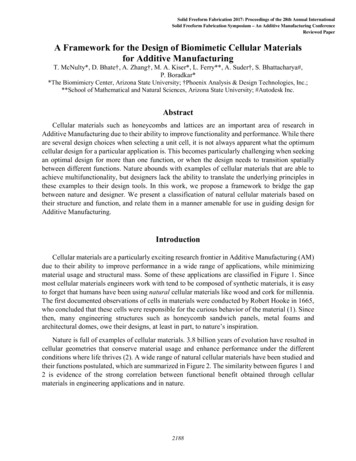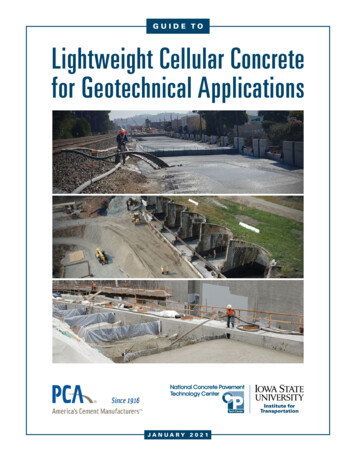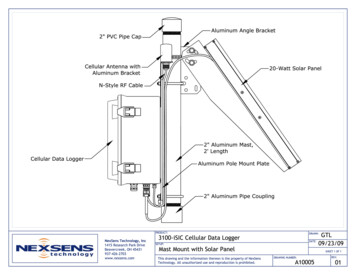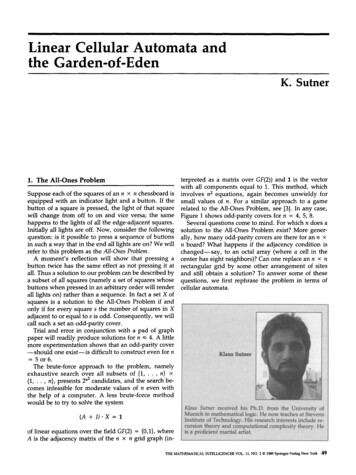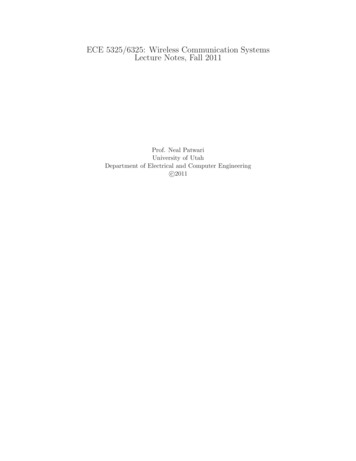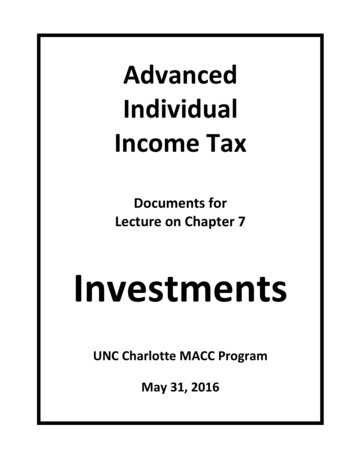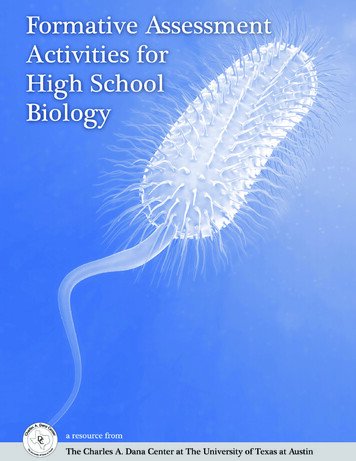
Transcription
Formative Assessment Activities for High School BiologyCellular ProcessesOxygen GlucoseChloroplastMitochondrionCarbon Dioxide WaterCell Structure and FunctionCELLULAR PROCESSESThe Charles A. Dana Center at The University of Texas at Austin23
Formative Assessment Activities for High School Biology24The Charles A. Dana Center at The University of Texas at Austin
Formative Assessment Activities for High School BiologyCellular ProcessesCell Structure and FunctionCELLULAR PROCESSESTeacher PagesPurposeThe purpose of this station is to have students compare the reactants and products ofphotosynthesis with the reactants and products of cellular respiration to reinforce theirunderstanding of the cellular processes that result in energy conversions and the synthesis ofnew molecules.Essential Understandings The products and reactants for photosynthesis are reversed in cellular respiration: Thereactants of photosynthesis are carbon dioxide and water, which are the products ofcellular respiration. The reactants of cellular respiration are oxygen and sugar, whichare the products of photosynthesis. Cellular respiration occurs in plant and animal cells. Plants use sunlight during photosynthesis to convert energy from the sun in order tomanufacture sugar and the chemical energy ATP and to release oxygen. ATP is used by plant and animal cells. As cellular respiration occurs, ATP is converted to ADP. When plants are placed in darkness, cellular respiration continues, using ATP toconvert sugar into ADP and releasing carbon dioxide. Photosynthesis stops in theabsence of light energy. The chemical formula for photosynthesis is6H2O 6CO2 èC6H12O6 6O2 ATPThe chemical formula for cellular respiration isC6H12O6 6O2è6H2O 6CO2 ADPMaterials Test tubes, 20 mm x 150 mm, and stoppers (8 each)Test tube racks (2)Distilled water (1 liter)Food coloring (blue and yellow)Plastic aquatic plant (4 sprigs)Aquatic snail shells (4)Envelope, standard size or larger (1)The Charles A. Dana Center at The University of Texas at AustinTeacher Pages25
Cellular ProcessesFormative Assessment Activities for High School BiologyThe following materials are included in the blackline masters for this station, which are availablein color on the enclosed DVD. Station Information sheet (1 per station) Cellular Respiration and Photosynthesis sheet (1 per station) Comparing Photosynthesis and Cellular Respiration Venn diagram (1 per station) Cellular Respiration and Photosynthesis Cards (1 set per station) Comparing Photosynthesis to Cellular Respiration Cards (1 set per station) Student Pages (1 copy per student)Supplementary ResourcesCellular Respiration. Retrieved on February 11, 2011 from the Biology page on esses/a/cellrespiration.htmFarabee, M. J. Photosynthesis. Retrieved on February 11, 2011 from the website of MaricopaCommunity College: www.emc.maricopa.edu/faculty/farabee/ BIOBK/BioBookPS.html.Advance Preparation261.Print one copy of all the blackline masters for this station from the enclosed DVD usinga color printer. Color is essential to the station activities. Make one copy of the StudentPages (including the glossary) for each student.2.Laminate the Station Information sheet, the sheet of Cellular Respiration andPhotosynthesis Cards, and the sheet of Comparing Photosynthesis to Cellular RespirationCards. Cut out the cards.3.Label one of the envelopes “Cellular Respiration and Photosynthesis,” and label the otherone “Comparing Photosynthesis to Cellular Respiration.” Put the cut-out cards in theappropriate envelopes.4.Part of this station activity has students observe the results of an experiment in which theprocesses of cellular respiration and photosynthesis caused liquids to change color. Theexperiment will not actually be conducted; instead, you will create a model of the results,and students will observe those results and answer questions about what led to them.5.You will use the eight test tubes to create the model of the experiment’s results. Four testtubes will be used to create “Exposed to Sunlight for 48 Hours,” and the remaining fourwill be used to create “Placed in the Dark for 48 Hours.”Teacher PagesThe Charles A. Dana Center at The University of Texas at Austin
Cellular ProcessesFormative Assessment Activities for High School BiologyPlace four test tubes in one of the racks and mark the rack, “Exposed to Sunlight for 48 Hours,”then: Fill three of the test tubes approximately 3/4 full with distilled water. Add two drops ofblue food coloring to each test tube. Place a stopper in one of the test tubes. The bluefood coloring simulates the Bromothymol blue indicator. Put one sprig of a plastic aquatic plant into each of the other two test tubes that haveblue food coloring. Put a stopper in one of the test tubes. Add a snail shell to the othertest tube and then stopper it. Fill the remaining test tube approximately 3/4 full with distilled water. Add three or fourdrops of yellow food coloring. Place a snail shell in the test tube and seal with a stopper.The yellow food coloring simulates the color change Bromothymol blue undergoes in anacidic solution.This set should look like the model below.Exposed to SUNLIGHT for 48 hoursS-1S-2S-3S-4water andBromothymolbluewater,Bromothymolblue, andplantwater,Bromothymolblue, andsnailwater,Bromothymolblue, plant,and snailThe Charles A. Dana Center at The University of Texas at AustinTeacher Pages27
Cellular ProcessesFormative Assessment Activities for High School BiologyMark the other test tube rack “Placed in Darkness for 48 Hours,” then: Fill each of the test tubes approximately 3/4 full with distilled water. Add two drops ofblue food coloring to one test tube and place a stopper in it. In the remaining three test tubes, add three to four drops of yellow food coloring. Add onesprig of plastic aquatic plant to one test tube and seal it with a stopper. Add a snail shell to another test tube filled with yellow water and close it with a stopper. In the final test tube, place one sprig of plastic aquatic plant and a snail shell, and closeit with a stopper.This set should look like the model IGHThoursD-1D-2D-3D-4water andBromothymolbluewater,Bromothymolblue, andplantwater,Bromothymolblue, andsnailwater,Bromothymolblue, plant,and snailStation Setup281.Tape the laminated Station Information sheet onto the station table. Students will usethis to confirm the station is set up correctly.2.Place the two racks of test tubes at the station table.3.Put the Cellular Respiration and Photosynthesis sheet and cards and the ComparingCellular Respiration to Photosynthesis Venn diagram and cards at the table.Teacher PagesThe Charles A. Dana Center at The University of Texas at Austin
Formative Assessment Activities for High School BiologyCellular ProcessesProcedures1.When students arrive at the station, they should check the station setup against theStation Information sheet. If anything is missing or out of place, they should notify you.2.Pass out a copy of the Student Pages to each student. Instruct students to work throughthe procedures and answer the questions with their teammate(s).3.As students work through the station activity, circulate around the room, checking theirwork and responding to questions.Guide to Student ResponsesNote: The suggested student responses presented below in italics represent the best possible answers to the studentquestions; actual student responses may vary.Essential QuestionHow can the processes of photosynthesis and cellular respiration be used to explain energyconversion?Photosynthesis requires light energy from a source like the sun to bond carbondioxide and water molecules together. This stored energy is the ATP molecules ina cell. During cellular respiration, the ATP molecules are used to break the bondsholding the sugar molecule together, converting the ATP into ADP.Radiant energy from the sun is converted into chemical energy throughphotosynthesis and is used in the process of cellular respiration.The Charles A. Dana Center at The University of Texas at AustinTeacher Pages29
Cellular ProcessesFormative Assessment Activities for High School BiologyActivities and Questions1.Select the cards that show the reactant and product parts of the formulas forphotosynthesis and cellular respiration. Place the appropriate card over the correct box onthe sheet. Continue until you have covered all of the boxes.A correctly completed sheet is shown below.Cellular Respiration and PhotosynthesissunOxygen GlucoseengyerChloroplastMitochondrionCarbon dioxide 6CO2WaterChemical Equation for PhotosynthesisReactants6H2O lightenergyenergyProductsC6H12O6 6O2Chemical Equation for Cellular RespirationC6H12O62. 6O26H2O 6CO2 ATPWrite the formulas for photosynthesis and cellular respiration in the space below.Photosynthesis: water carbon dioxide light energy (yields) sugar oxygenCellular Respiration: sugar oxygen (yields) carbon dioxide water ATP3.What cellular process took place to cause the color change in Tube S-3, which containswater, Bromothymol blue, and snail?The process that caused the color change is called cellular respiration. TheBromothymol blue indicator changes from blue to yellow in the presence of an acid.In this case, the acid resulted from the snail’s cellular respiration process. Duringthis process, the snail exhales carbon dioxide, which combines with water to forma weak carbonic acid, which in turn changes the color of the water from blue toyellow.H2O CO2 g H2CO330Teacher PagesThe Charles A. Dana Center at The University of Texas at Austin
Cellular ProcessesFormative Assessment Activities for High School Biology4.Why did the other test tubes containing water, Bromothymol blue, and plants not changecolor?The plants were going through the process of photosynthesis, which uses up carbondioxide in the water. If carbon dioxide is not present, the weak carbonic acid cannotform, and the solution does not turn acidic. Therefore, the Bromothymol blueindicator remains blue.5.What process caused the liquids to change from blue to yellow?The process is called cellular respiration.6.What product in the formula was responsible for the color change?The product responsible for the change is CO2.7.Explain the cellular processes illustrated by these two test tubes, including energyconversions and any new molecules that result.Sunlight48 hoursDarkness48 hoursS-4D-4water,Bromothymolblue, plant,and snailwater,Bromothymolblue, plant,and snailThe two cellular processes illustrated by the test tubes are cellular respiration andphotosynthesis. During cellular respiration, the reactants—glucose (sugar) andoxygen—combine together to form new products: carbon dioxide molecules andwater molecules. Adenosine triphosphate (ATP) is produced as the form of energythat can be used for other cellular processes.During photosynthesis, light energy (sunlight) combines with the reactants—waterand carbon dioxide—to form new products: glucose (sugar) and oxygen.The Charles A. Dana Center at The University of Texas at AustinTeacher Pages31
Cellular Processes8.Formative Assessment Activities for High School BiologyPlace the cards in the correct area of the Venn diagram and record your placementsbelow.The ProcessesProcesses ularRespirationRespirationPhotosynthesisProcess occurs onlyin plant cellsReactants includeCO2Reactants includeH2OCommon to BothATP provides energy forcellular functionsNew molecules includeCO2 and H2OProcess occurs in plantand animal cellsAdenosine triphosphate (ATP)is produced during glycolysisProcess occurs in amitochondrionProcess occurs in achloroplastReactantsinclude O2New moleculesinclude O2New molecules includeC6H12O6Process occursonly during daylight9.Cellular RespirationReactants includeC6H12O6Process occurs duringdaylight or darkNow that you have completed these questions, return to the essential question. Wouldyou like to modify or change your answer? Write any modifications to your answer below.Answers will vary.32Teacher PagesThe Charles A. Dana Center at The University of Texas at Austin
Formative Assessment Activities for High School BiologyCellular ProcessesThe Charles A. Dana Center at The University of Texas at AustinTeacher Pages33
Cellular Processes34Teacher PagesFormative Assessment Activities for High School BiologyThe Charles A. Dana Center at The University of Texas at Austin
Formative Assessment Activities for High School BiologyCellular ProcessesCell Structure and FunctionCELLULAR PROCESSESBlackline MastersContents Station Information sheet Cellular Respiration and Photosynthesis sheet Comparing Photosynthesis and Cellular Respiration Venn diagram Cellular Respiration and Photosynthesis Cards Comparing Photosynthesis to Cellular Respiration Cards Student PagesThe Charles A. Dana Center at The University of Texas at AustinBlackline Masters35
Cellular ProcessesFormative Assessment Activities for High School BiologyStation Information:Cellular ProcessesResults after being placed in DARKNESS for 48 hoursResults after being placed in SUNLIGHT for 48 hoursCellular Respiration and PhotosynthesissunOxygen GlucosedecluNewmolecH ules2OinH2OCO 2dets inwm occursProcessolec lightduring dayO ules2incluaWaterinrsccu ts o lasces loropchC6H12O6tan New molecules includeacReCarbon dioxideenergyProMitochondrionReactants includegyerenChloroplastReactants includeC6H12O6NedecluComparing Photosynthesis toCellularReactantsRespirationinclude CardsChemical Equation for PhotosynthesisReactants energysourceO2Products Comparing Cellular Respiration to PhotosynthesisChemical Equation for Cellular Respiration energyreceiverPhotosynthesisCellular RespirationCommon to Both26HO26Chtlig ergyenATPC6H12O66O26O2OO26C6H2OCellular Respiration andPhotosynthesis CardsC6H12O636Blackline MastersThe Charles A. Dana Center at The University of Texas at Austin
sunThe Charles A. Dana Center at The University of Texas at Austin Reactantsenergy Carbon Dioxide WaterGlucose Chemical Equation for Cellular Respirationenergysource energyreceiverenergy ProductsMitochondrionChemical Equation for PhotosynthesisChloroplastOxygenCellular Respiration and PhotosynthesisFormative Assessment Activities for High School BiologyCellular ProcessesBlackline Masters37
38Common to BothCellular RespirationFormative Assessment Activities for High School BiologyPhotosynthesisComparing Cellular Respiration to PhotosynthesisCellular ProcessesBlackline MastersThe Charles A. Dana Center at The University of Texas at Austin
Cellular ProcessesFormative Assessment Activities for High School BiologyCellular Respiration and Photosynthesis nergyComparing Photosynthesis to Cellular Respiration CardsNew molecules includeReactants includeNew moleculesinclude O2Reactantsinclude O2Process occurs onlyin plant cellsProcess occurs in plantand animal cellsReactantsinclude H2OProcess occurs in amitochondrionReactantsinclude CO2ATP provides energy forcellular functionsProcess occurs duringdaylight or darkProcess occurs in achloroplastProcess occursonly during daylightAdenosine triphosphate (ATP)produced during glycolysisC6H12O6C6H12O6The Charles A. Dana Center at The University of Texas at AustinNew molecules includeCO2 and H2OBlackline Masters39
Cellular Processes40Blackline MastersFormative Assessment Activities for High School BiologyThe Charles A. Dana Center at The University of Texas at Austin
Formative Assessment Activities for High School BiologyCellular ProcessesCell Structure and FunctionCELLULAR PROCESSESStudent PagesPurposeThe purpose of this station is to compare the reactants and products of photosynthesis with thereactants and products of cellular respiration to reinforce your understanding of the cellularprocesses that result in energy conversions and the synthesis of new molecules.Before You Begin Check to see that all the items are present and organized according to the Station Informationsheet. If you notice a problem, notify the teacher immediately.Materials Station Information sheet Two test tube racks with four test tubes each Cellular Respiration and Photosynthesis sheet Comparing Photosynthesis and Cellular Respiration Venn diagram Envelope containing Cellular Respiration and Photosynthesis Cards Envelope containing Comparing Photosynthesis and Cellular Respiration CardsActivities and QuestionsEssential QuestionHow can the processes of photosynthesis and cellular respiration be used to explain energyconversion?Discuss the essential question with your teammate(s) and record your answer below.The Charles A. Dana Center at The University of Texas at AustinStudent Pages41
Cellular ProcessesFormative Assessment Activities for High School BiologyLocate the Photosynthesis and Cellular Respiration sheet and the envelope with thePhotosynthesis and Cellular Respiration Cards.1.Select the cards that show the reactant and product parts of the formulas forphotosynthesis and cellular respiration. Place the appropriate card over the correct box onthe sheet. Continue until you have covered all the boxes.2.Write the formulas for photosynthesis and cellular respiration in the space below.Bromothymol blue is an indicator that changesfrom blue to yellow in the presence of an acid.When you exhale through a straw into a testtube of Bromothymol blue and water, the waterwill turn yellow because the carbon dioxidebeing exhaled combines with the water to forma weak carbonic acid.H2O CO2 g H2CO3 (carbonic acid)yellowcolorbluecolorBromothymol blueand water42Student PagesBromothymol bluewith CO2 bubbledinto the waterThe Charles A. Dana Center at The University of Texas at Austin
Cellular ProcessesFormative Assessment Activities for High School BiologyIn an experiment, four test tubes were filled with a mixture of Bromothymol blue and water. Thefirst test tube contains only the liquid. An aquatic plant was added to the second test tube, and asnail to the third one. The last test tube contains both an aquatic plant and a snail.Original Setupwater andBromothymolbluewater,Bromothymolblue, andplantwater,Bromothymolblue, andsnailwater,Bromothymolblue, plant,and snailNote: When making observations about each test tube and answering questions about your observations, you mayrefer to the test tubes provided at the station or the pictures that are included in the student pages.The Charles A. Dana Center at The University of Texas at AustinStudent Pages43
Cellular ProcessesFormative Assessment Activities for High School BiologyThe four test tubes were placed in sunlight for 48 hours. When the test tubes were observed atthe end of the 48 hours, the following changes had occurred.Exposed to SUNLIGHT for 48 hours44S-1S-2S-3S-4water andBromothymolbluewater,Bromothymolblue, andplantwater,Bromothymolblue, andsnailwater,Bromothymolblue, plant,and snail3.What cellular process took place to cause the color change from blue to yellow in TubeS-3, which contains water, Bromothymol blue, and a snail?4.Why did the other test tubes containing water, Bromothymol blue, and plants not changecolor?Student PagesThe Charles A. Dana Center at The University of Texas at Austin
Cellular ProcessesFormative Assessment Activities for High School BiologyFour more test tubes were set up the same as the original four. These test tubes were placed in adark room for 48 hours. At the end of the 48 hours, the following changes were observed.Results after being placed in DARKNESS for 48 hoursD-1D-2D-3D-4water andBromothymolbluewater,Bromothymolblue, andplantwater,Bromothymolblue, andsnailwater,Bromothymolblue, plant,and snailThe water in three of the test tubes (D-2, D-3, and D-4) turned yellow, as shown above.5.What process caused the liquids to change from blue to yellow?6.What product in the formula was responsible for the color change?The Charles A. Dana Center at The University of Texas at AustinStudent Pages45
Cellular ProcessesFormative Assessment Activities for High School BiologyExamine the two test tubes below.7.Sunlight48 hoursDarkness48 hoursS-4D-4water,Bromothymolblue, plant,and snailwater,Bromothymolblue, plant,and snailExplain the cellular processes illustrated by these two test tubes, including energyconversions and any new molecules that result.Locate the Comparing Photosynthesis and Cellular Respiration Venn diagram and the envelopewith the Photosynthesis and Cellular Respiration Cards. Determine which cards represent factsabout cellular respiration and which represent facts about photosynthesis. Some cards mayrepresent facts common to both processes.46Student PagesThe Charles A. Dana Center at The University of Texas at Austin
Formative Assessment Activities for High School BiologyCommon to BothCellular RespirationPlace the cards in the correct area of the Venn diagram and record your placementsbelow.PhotosynthesisComparing Cellular Respiration to Photosynthesis8.Cellular ProcessesThe Charles A. Dana Center at The University of Texas at AustinStudent Pages47
Cellular Processes9.Formative Assessment Activities for High School BiologyNow that you have completed these questions, return to the essential question. Wouldyou like to modify or change your answer? Write any modifications to your answer below.Note: Because other students are going to do the activity after you, be sure to put all the materials at the stationback as you found them. Sometimes there will be materials that need to be renewed or replaced. If you needassistance or have any questions, ask your teacher.48Student PagesThe Charles A. Dana Center at The University of Texas at Austin
Formative Assessment Activities for High School BiologyCellular ProcessesI Need to Remember . . .Complete this part after class discussion of this station.I need to remember . . .The Charles A. Dana Center at The University of Texas at AustinStudent Pages49
Cellular ProcessesFormative Assessment Activities for High School BiologyGlossary for Cellular ProcessesAdenosine triphosphate (ATP)A chemical compound that living organisms use to store energy.Bromothymol blue indicatorBromothymol blue indicator is used to determine whether a solution is acidic: The bluecolor changes to yellow in the presence of an acid.Cellular RespirationThe cellular process that releases energy when food molecules are broken down in thepresence of oxygen.PhotosynthesisThe cellular process through which plants and other organisms use energy from light(such as sunlight) to convert water and carbon dioxide into oxygen, sugars, and starches.ProductsProducts, represented on the right side of the arrow in a chemical equation, are theending substances in a reaction.ReactantsReactants, represented on the left side of the arrow in a chemical equation, are thestarting substances in a reaction.50Student PagesThe Charles A. Dana Center at The University of Texas at Austin
Formative Assessment Activities forHigh School BiologyActivities designed to reinforce student knowledge of essential biologyconcepts.Available as a full-color electronic file on a DVD or coil-bound book, thisitem provides 18 hands-on, interactive activities designed to reinforcestudents’ knowledge of essential biology concepts in five categories:cell structure and function, mechanisms of genetics, biologicalevolution and classification, biological processes and systems, andinterdependence within environmental systems.A DVD containing the full-color book is included.DVD with teacher and student resources: 30.00Full Color Printed Book: 110.00
28 Teacher Pages The Charles A. Dana Center at The University of Texas at Austin Cellular Processes Formative Assessment Activities for High School Biology Formative Assessment Activities for High School Biology Mark the other test tube rack "Placed in Darkness for 48 Hours," then: Fill each of the test tubes approximately 3/4 full with distilled water.




